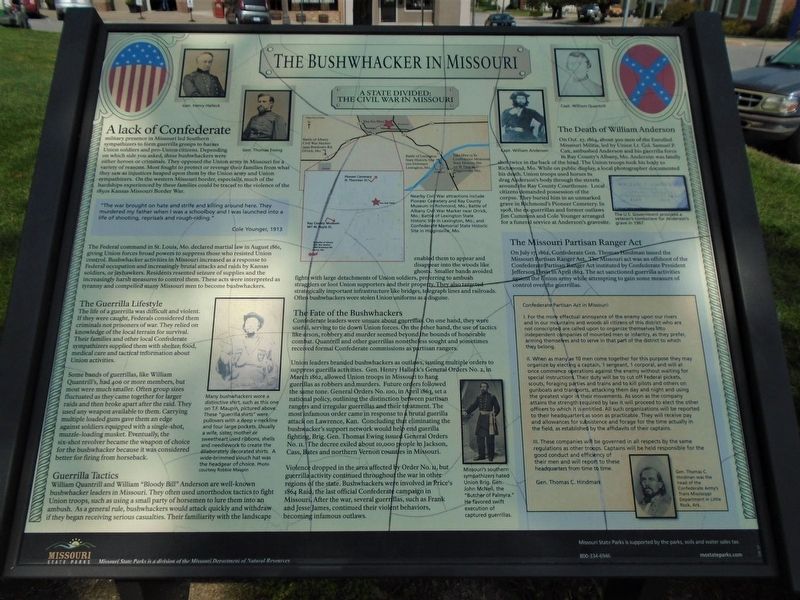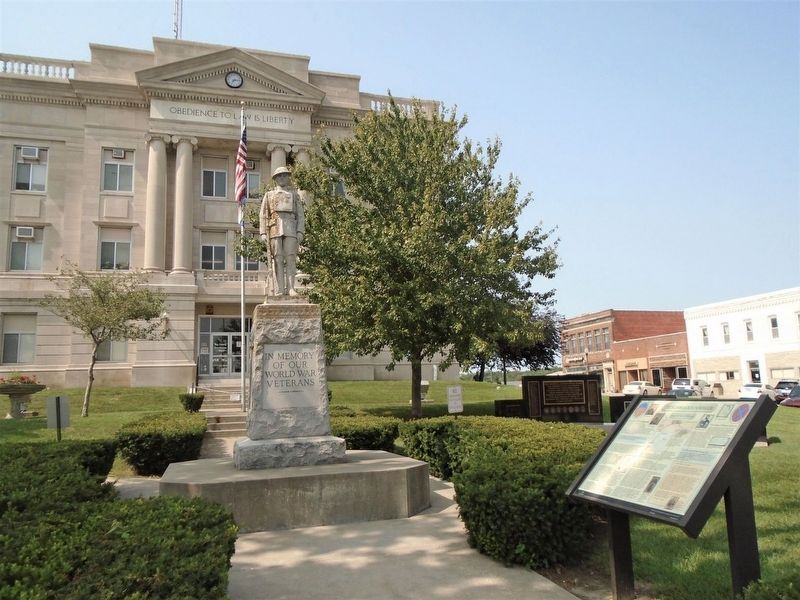The Bushwhacker in Missouri
A State Divided: The Civil War in Missouri
A lack of Confederate military presence in Missouri led Southern sympathizers to form guerrilla groups to harass Union soldiers and pro-Union citizens. Depending on which side you asked, these bushwhackers were either heroes or criminals. They opposed the Union army in Missouri for a variety of reasons. Most fought to protect or revenge their families from what they saw as injustices heaped upon them by the Union army and Union sympathizers. On the western Missouri border, especially, much of the hardships experienced by these families could be traced to the violence of the 1850s Kansas Missouri Border War.
"The war brought on hate and strife and killing around here. They murdered my family when I was a schoolboy and I was launched into a life of shooting, reprisals and rough-riding."
Cole Younger, 1913
The Federal command in St. Louis, Mo. declared martial law in August 1861, giving Union forces broad powers to suppress those who resisted Union control. Bushwhacker activities in Missouri increased as a response to Federal occupation and increasingly brutal attacks and raids by Kansas soldiers, or jayhawkers. Residents resented seizure of supplies and the increasingly harsh measures to control them. These acts were interpreted as tyranny and compelled many Missouri men to become bushwhackers.
The Guerrilla
Lifestyle
The life of a guerrilla was difficult and violent. If they were caught, Federals considered them criminals not prisoners of war. They relied on knowledge of the local terrain for survival. Their families and other local Confederate sympathizers supplied them with shelter, food, medical care and tactical information about Union activities.
Some bands of guerrillas, like William Quantrill's, had 400 or more members, but most were much smaller. Often group sizes fluctuated as they came together for larger raids and then broke apart after the raid. They used any weapon available to them. Carrying multiple loaded guns gave them an edge against soldiers equipped with a single-shot, muzzle-loading musket. Eventually, the six-shot revolver became the weapon of choice for the bushwhacker because it was considered better for firing from horseback.
Guerrilla Tactics
William Quantrill and William "Bloody Bill" Anderson are well-known bushwhacker leaders in Missouri. They often used unorthodox tactics to fight Union troops, such as using a small party of horsemen to lure them into an ambush. As a general rule, bushwhackers would attack quickly and withdraw if they began receiving serious casualties. Their familiarity with the landscape enabled them to appear and disappear into the woods like ghosts. Smaller bands avoided fights with larger detachments
The Fate of the Bushwhackers
Confederate leaders were unsure about guerrillas. One one hand, they were useful, serving to tie down Union forces. On the other hand, the use of tactics like arson, robbery and murder seemed beyond the bounds of honorable combat. Quantrill and other guerrillas nonetheless sought and sometimes received formal Confederate commissions as partisan rangers.
Union leaders branded bushwhackers as outlaws, issuing multiple orders to suppress guerilla activities. Gen. Henry Halleck's General Orders No. 2, in March 1862, allowed Union troops in Missouri to hang guerillas as robbers and murder[er]s. Future orders followed the same tone. General Orders No. 100, in April 1863, set a national policy, outlining guerrillas and their treatment. The most infamous order came in response to a brutal guerilla attack on Lawrence, Kan. Concluding that eliminating the bushw[h]acker's support network would help end guerilla fighting, Brig. Gen. Thomas Ewing issued General Orders No. 11. The decree exiled about 10,000 people in Jackson, Cass, Bates and northern Vernon counties in Missouri.
Violence
dropped in the area affected by Order No. 11, but guerrilla activity continued throughout the war in other regions of the state. Bushwhackers were involved in Price's 1864 Raid, the last official Confederate campaign in Missouri. After the war, several guerrillas, such as Frank and Jesse James, continued their violent behaviors, becoming infamous outlaws.
The Death of William Anderson
On Oct. 27, 1864, about 300 men of the Enrolled Missouri Militia, led by Union Lt. Col. Samuel P. Cox, ambushed Anderson and his guerrilla force in Ray County's Albany, Mo. Anderson was fatally shot twice in the back of the head. The Union troops took his body to Richmond, Mo. While on public display, a local photographer documented his death. Union troops used horses to drag Anderson's body through the streets around the Ray County Courthouse. Local citizens demanded possession of the corpse. They buried him in an unmarked grave in Richmond's Pioneer Cemetery. In 1908, the ex-guerrillas and former outlaws Jim Cummins and Cole Younger arranged for a funeral service at Anderson's gravesite.
The Missouri Partisan Ranger Act
On July 17, 1862, Confederate Gen. Thomas Hindman issued the Missouri Partisan Ranger Act. The Missouri act was an offshoot of the Confederate Partisan Ranger Act instituted by Confederate President Jefferson Davis in April 1862. The act sanctioned guerrilla activities against the Union army while attempting to gain some measure of control over the guerrillas.
Confederate Partisan Act in Missouri:
I. For the more effectual annoyance of the enemy upon our rivers and in our mountains and woods all citizens of this district who are not conscripted are called upon to organize themselves into independent companies of mounted men or infantry, as they prefer, arming themselves and to serve in that part of the district to which they belong.
II. When as many as 10 men come together for this purpose they may organize by electing a captain, 1 sergeant, 1 corporal, and will at once commence operation against the enemy without waiting for special instructions. Their duty will be to cut off Federal pickets, scouts, foraging parties and trains and to kill pilots and others on gunboats and transports, attacking them day and night and using the greatest vigor in their movements. As soon as the company attains the strength required by law it will proceed to elect the other officers to which it is entitled. All such organizations will be reported to their headquarters as soon as practicable. They will receive pay and allowance for subsistence and forage for the time actually in the field, as established by the affadavits of their captains.
III. These companies will be governed in all respects by the same regulations as other troops. Captains will be held responsible for the good conduct and efficiency of their men and will report to these headquarters from time to time.
Gen. Thomas C. Hindman
[Photo captions, clockwise from top left, read]
• Gen. Henry Halleck
• Gen. Thomas Ewing
• [Map inset] Nearby Civil War attractions include Pioneer Cemetery and Ray County Museum in Richmond, Mo.; Battle of Albany Civil War Marker near Orrick, Mo.; Battle of Lexington State Historic Site in Lexington, Mo.; and Confederate Memorial State Historic Site in Higginsville, Mo.
• Capt. William Anderson
• Capt. William Quantrill
• The U.S. Government provided a veteran's tombstone for Anderson's grave in 1967.
• Gen. Thomas C. Hindman was the head of the Confederate Army's Trans Mississippi Department in Little Rock, Ark.
• Missouri's southern sympathizers hated Union Brig. Gen. John McNeil, the "Butcher of Palmyra." He favored swift execution of captured guerrillas.
• Many bushwhackers wore a distinctive shirt, such as this one on T.F. Maupin, pictured above. These "guerrilla shirts" were pullovers with a deep v-neckline and four large pockets. Usually a wife, sister, mother or sweetheart used ribbons, shells and needlework to create the ellaborately [sic] decorated shirts. A wide-brimmed slouch hat was the headgear of choice.
Erected by Missouri State Parks.
Topics and series. This historical marker is listed in these topic lists: Settlements & Settlers • War, US Civil. In addition, it is included in the Missouri - A State Divided: The Civil War in Missouri series list. A significant historical year for this entry is 1913.
Location. 39° 16.725′ N, 93° 58.603′ W. Marker is in Richmond, Missouri, in Ray County. Marker is on Thornton Street north of Main Street (State Highway 10), on the left when traveling north. Marker is on the Ray County Courthouse grounds. Touch for map. Marker is at or near this postal address: 100 West Main Street, Richmond MO 64085, United States of America. Touch for directions.
Other nearby markers. At least 8 other markers are within walking distance of this marker. World War Memorial (here, next to this marker); World War II and Korean War Memorial (a few steps from this marker); Vietnam War Memorial (a few steps from this marker); Richmond (within shouting distance of this marker); Pvt. John Wallace (within shouting distance of this marker); Colonel Alexander W. Doniphan (within shouting distance of this marker); Ray County Bicentennial Memorial (about 300 feet away, measured in a direct line); 1856 Courthouse Cornice Planter (about 300 feet away). Touch for a list and map of all markers in Richmond.
Also see . . .
1. Bushwhackers and Jayhawkers. Community & Conflict website entry (Submitted on October 1, 2020, by William Fischer, Jr. of Scranton, Pennsylvania.)
2. Partisan Warfare in the American Civil War. eHistory website entry (Submitted on October 1, 2020, by William Fischer, Jr. of Scranton, Pennsylvania.)
3. Forces of Change and the Enduring Ozark Frontier: The Civil War. NPS Ozark Historic Research Study (Submitted on October 1, 2020, by William Fischer, Jr. of Scranton, Pennsylvania.)
Credits. This page was last revised on February 20, 2023. It was originally submitted on October 1, 2020, by William Fischer, Jr. of Scranton, Pennsylvania. This page has been viewed 1,119 times since then and 170 times this year. Photos: 1, 2. submitted on October 1, 2020, by William Fischer, Jr. of Scranton, Pennsylvania.

